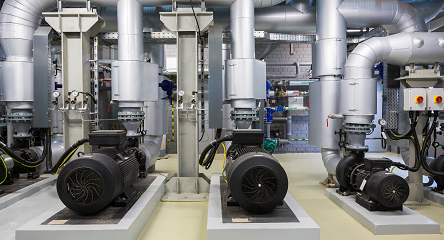Industrial Internet of Things (IIoT) finds many application fields today in the industry by connecting assets to each other, gathering data and transferring it to other internet-enabled systems. One area that is transformed significantly with IIoT technologies is predictive maintenance, which is a technique to predict when an asset might fail by analyzing the parameters related to the asset’s health status. Compared with conventional preventive maintenance, predictive maintenance offers minimized unplanned downtimes and reduced maintenance costs for critical assets, such as gearboxes, pumps, fans and electrical motors.
With IIoT, an online diagnostics project can be executed as part of a predictive maintenance program, enabling users to monitor asset conditions remotely and diagnose malfunctions. An online diagnostics project offers various benefits. A diagnostics capability enable to identify malfunction root causes, which minimizes asset downtimes and maintenance efforts. By use of online platforms, it is possible to access asset data from anywhere. A central location can monitor separate remote facilities and collect data from dangerous manufacturing environments.
Achieving precise diagnostics of emerging malfunctions requires many items to be considered and fulfilled. This article handles the topic in a technical aspect, and for those looking to gain more insight into the subject, it briefly lists below the nine key points to execute a successful online diagnostics project.
1- Choose the Correct Type of Hardware That Meet Your Needs.
The asset parameters that will be monitored determine the type of sensors and data loggers to be used. For rotating assets, vibration monitoring provides the most detailed insight. During the sensor and data logger selection, it is crucial to clarify the expected vibration magnitudes, asset working frequencies, and the frequency region that diagnostic analysis will take place. Depending on the asset and its failure modes, additional parameters such as temperature, rotation speed and magnetic field may need to be monitored.
2- Take Into Account the Environmental Conditions.
Will the monitoring system’s location be in an open area or closed doors? If it is an open area in a cement or steel factory, sensors and data loggers (if there is any) may need water and dust ingress protection. In another case, for the sensors inside gearboxes that are subject to lubricants, submersible type sensors may be the choice. Some facilities, such as in the oil & gas sector, require special approvals like ATEX certification.
3- Wired or Wireless System?
With a wireless monitoring system, site sensors send wireless signals to a gateway, which transmits the data to a cloud database via an internet connection. Wireless sensors are feasible for remote and hard to access locations or facilities with many assets in separate areas. No signal cabling requirement makes it easy to extend the system and increase the number of monitored assets. Wireless sensors generally use a battery as a power source, and battery life may impose limitations on data acquisition periods and the amount of data transmitted to the cloud. Regarding vibration measurements, frequent upload of raw vibration data to the cloud to examine the frequency spectrum affects battery life.
Wired monitoring systems are composed of sensors and data loggers. Wired monitoring systems are perceived as a reliable solution in data transmission since there is a direct connection between the sensor and the data logger. Data loggers mainly use DC power supply; it is possible to transfer any data size to the cloud at any time interval.
For both the wired and wireless solutions, an edge computing capability offers advantages for the monitoring process. Edge computing is useful to prevent overload on the cloud both in terms of computing and data storage. In vibration monitoring, with edge computing, a sensor or data logger extracts critical features from the raw vibration data and continuously compares them with the alarm thresholds. In this way, while measurement data is transmitted to the cloud in periods, like per hour, the monitoring system will continuously analyze the parameters at the site and provide notification in case of an alarm situation.
4- Ensure Robust Internet Connectivity.
A robust internet connection is crucial for a sustainable online diagnostics program. If cable or fiber internet infrastructure is not available for the facilities located at remote geographies, the site team may prefer a cellular or satellite connection. Monitoring systems with a stand-alone mode is useful during connection downtimes, which sends a digital signal to the facility’s local control system if a monitored parameter breaches an alarm threshold. In this way, the site team can follow asset conditions locally.
5- Transfer Data from the Facility’s Control System.
Asset parameter monitoring won’t be enough alone for the precise diagnostics of specific failure modes. For example, a centrifugal pump’s high-frequency vibration signature can indicate either an initiating bearing malfunction or hydraulic cavitation. In this aspect, process data such as pressure, flow rate, and pump suction chamber water level should be extracted from the facility’s control system (such as SCADA) to understand pump operating conditions and place correct diagnosis. Depending on the type of monitored asset, different process and environment parameters may be needed to monitor.
6- Analytic Capabilities: In-House Team or Outsourcing?
One of the biggest challenges that facilities face today to initiate an online diagnostics project is the lack of expertise to analyze the data and convert it into actionable insight. An experienced diagnostics engineer is the most valuable part of an online diagnostics program. Depending on in-house resources and whether it is seen as a primary task, facilities can either establish an in-house diagnostics team by training their staff or outsource it. Depending on the staff’s knowledge level, an in-house online diagnostics program may require patience and time to achieve satisfactory results.
7- Continuous Monitoring Means Continuous Communication.
Online monitored data alone may not display the complete picture of an asset’s health condition. The diagnostics team should regularly communicate with the site team about operation and maintenance activities. Going over a pump example, sometimes pump operators can use packings as a tool to control/cool the temperature of the shaft and bearing housings. However, if the amount of water leaked from the packing is more than the pump manufacturer’s recommendation, this may indicate a problem since an excessive amount of water is needed to cool the shaft and bearing housing. A remote diagnostics engineer may not notice this problem by monitoring the temperature data, which will stay within limits.
8- Manage the Data.
The amount of data generated by the monitoring system will increase in size with time. Data is your property, and it should be easy to transfer it to any online platform (with file formats such as CSV or XML) you aim to for back-up, database managing, or other purposes.
Determining the optimum data upload interval to the cloud is also essential for effective data management. As described previously, an edge computing capability serves this purpose well and reduces the cloud’s data load.
9- Pay Attention to Reports.
Asset health status reports are essential to establish communication between diagnostics engineers, plant maintenance team and plant management. A systematic report generation mechanism and proper documentation is crucial to preserve the diagnostics experience and turn it into a cooperate know-how.
For instance, asset health status reports can be either scheduled or unscheduled. Scheduled reports are published regularly, such as weekly, and display the critical features of monitored data, trends, maintenance recommendations and an executive summary.
Unscheduled incident reports indicate fault detection. An incident report’s language should be straight, avoid too many technical terms, and make the parties understand the necessary actions against the issue.





